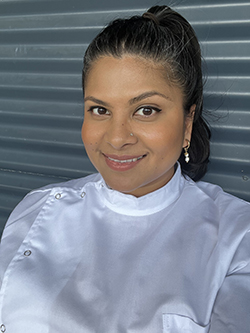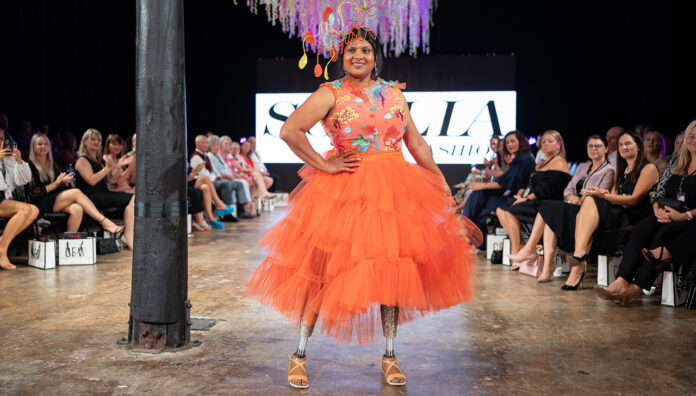Ahead of International Women’s Day (8 March 2024), AP speaks with an inspiring pharmacist who is challenging perceptions of beauty and what the healthcare workforce looks like.
Sara Shams hasn’t always had disability pride. In fact, the disability advocate, speaker, model, board member and pharmacist – who became a bilateral above the knee amputee at age 6 – spent most of her life hiding her disability.
Born in Bangladesh and raised in Australia, Ms Shams feels fortunate to have been provided with adaptive technology that improved her quality of life, including prosthetic legs and a wheelchair.
But the lack of representation of people with disability on every platform – including healthcare, the fashion industry, television and in leadership roles – impacted how she saw herself and her capabilities.
‘Even today, people with disabilities are underrepresented on boards, particularly women,’ she added.
Being a disabled woman of colour was another barrier Ms Shams faced. ‘It adds an extra level of challenges to everyday life.’
The campaign theme for IWD 2024 ‘inspire inclusion’, is all about the importance of diversity and empowerment in all aspects of society.
Ms Shams shares her journey towards disability visibility in healthcare, breaking down social barriers, and steps to make pharmacy a more inclusive space.
Destined to become a pharmacist
A big reason Ms Shams pursued pharmacy is her deep familial roots in healthcare. ‘Both my parents are doctors, and a lot of other family members are in healthcare professions,’ she said.
 It was also the empathy and compassion shown by pharmacists that drew her to the profession.
It was also the empathy and compassion shown by pharmacists that drew her to the profession.
However, when Ms Shams first entered the pharmacy workforce in 2012 as an intern, she encountered a different perspective.
‘As a young graduate going into my intern year, with a disability, I didn’t have the confidence to ask for the accommodations I needed,’ she said. ‘I was worried it might impact my role or how my abilities to do my job would be perceived.’
Community pharmacy can often be a prohibitive working environment for people with disability.
‘We often have to be on our feet for 10+ hours a day,’ said Ms Shams. ‘Being on prosthetic legs, it took a toll on me physically.’
While searching for internship positions, steps leading into the dispensary also took Ms Shams out of the running for several jobs, with fellow owner pharmacists often saying, ‘sorry, it’s not suitable for you’ or ‘it may be difficult for you to work here’.
‘There are many different types of disabilities, so asking what accommodations are needed is the best way to address any issues people may face throughout their career,’ she said.
Minor modifications can then be made to ensure an inclusive, welcoming workplace environment.
‘Little things such as offering a few more breaks throughout the day, or having a chair available so I can sit down when needed can make a significant difference,’ she said.
Space permitting, a ramp or railing could provide a workaround in a dispensary with steps.
‘Often, the solutions are already there because someone else has considered them,’ she said. ‘It’s just about taking the initiative to find alternatives.’
Now, Ms Shams works in an environment that’s been inclusive from the get-go.
‘From the start, they said, “if you need to sit down please let us know”, and they gave me hours which are better for me to drive to and from work.’
Big-picture thinking
Shaping healthcare policy is Ms Shams’ next career goal. Currently undertaking a master’s in public health, she hopes to put her lived experience with disability to good use to promote inclusion.
‘As a person with disability who has been on the NDIS, I know the impact health policies have at an individual level,’ she said.
Firstly, there should be more data available on the quality of support provided to people with disability within pharmacy to inform evidence-based policy, Ms Shams thinks.
‘Without data and research, we don’t know where the gaps are, and where the inequities lie in healthcare for people with disabilities.’
Having a general understanding of accessibility standards, and enshrining that in policy, is another important step.
‘For example, does the pharmacy have a disability action plan, or disability accessibility inclusion plan? Have they examined the premise to see where the gaps are?’ she said.
‘This includes looking at the requirements for various types of disabilities, and the communication strategies and accommodations we can make for customers, patients and employees with disabilities.
‘It’s also crucial to create a culture of inclusion, so employees are comfortable to be themselves and ask for accommodations.’
Training and education around disability awareness, along with cultural competency training, is also crucial – particularly in areas where there is high prevalence of CALD (culturally and linguistically diverse) groups.
‘Learning from lived experience can help to reduce stigma and improve overall interaction with individuals in the community.’
Moving on up
The turning point in Ms Shams’ journey with disability occurred when she reached 30.
After joining Instagram under the handle @nolegs_noworries – a nod to the school-yard bullies who used to call her ‘no legs Sara’ – Ms Shams saw representations of other people with missing limbs, in wheelchairs, and wearing prosthetic limbs – who were not only surviving, but thriving in life.
It was through her budding disability advocacy that Ms Shams came across a casting opportunity for a runway model.
‘There were all these tall, fully limbed models walking around,’ she said. ‘But I went ahead, threw my leg into the ring (pun intended) and I got in, which was shocking and amazing.’
After signing with an agency, Ms Shams has since added a few photoshoots and TV commercials to her name, along with two board director positions for not-for-profit organisations at Limbs4Life and Carers Queensland.
‘Even today, 20% of the Australian population has a disability, but only 1% is seen on television,’ she said.
‘That’s what keeps me going on this path, because authentic representation would have made a huge difference in my life when I was a child growing up, in my teenage years, and even in my twenties.’
Ms Shams wants to continue to empower others to take the next steps, question the status quo, and to use an intersectional lens when dismantling barriers.
‘We all deserve to be seen, heard and represented – be it in a pharmacy, on boards or a runway.’




 ‘We’re increasingly seeing incidents where alert fatigue has been identified as a contributing factor. It’s not that there wasn’t an alert in place, but that it was lost among the other alerts the clinician saw,’ Prof Baysari says.
‘We’re increasingly seeing incidents where alert fatigue has been identified as a contributing factor. It’s not that there wasn’t an alert in place, but that it was lost among the other alerts the clinician saw,’ Prof Baysari says.


 Beyond the arrhythmia, AF often signals broader pathological processes that impair cardiac function and reduce quality of life and life expectancy.5 Many of these conditions are closely linked to social determinants of health, disproportionately affecting populations with socioeconomic disadvantage. Effective AF management requires addressing both the arrhythmia and its underlying contributors.4
Beyond the arrhythmia, AF often signals broader pathological processes that impair cardiac function and reduce quality of life and life expectancy.5 Many of these conditions are closely linked to social determinants of health, disproportionately affecting populations with socioeconomic disadvantage. Effective AF management requires addressing both the arrhythmia and its underlying contributors.4  C – Comorbidity and risk factor management
C – Comorbidity and risk factor management Warfarin
Warfarin




